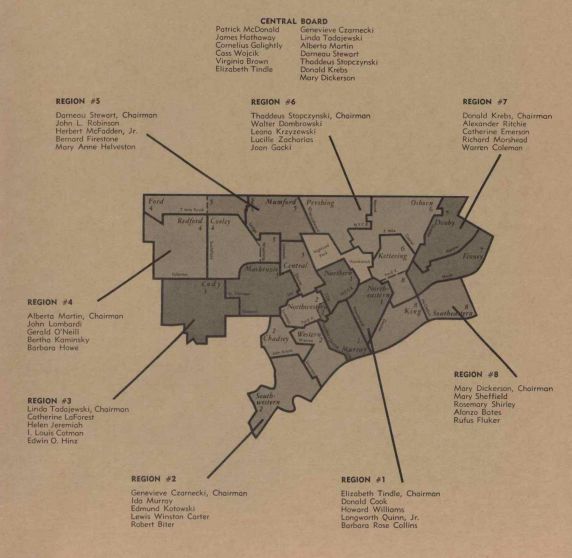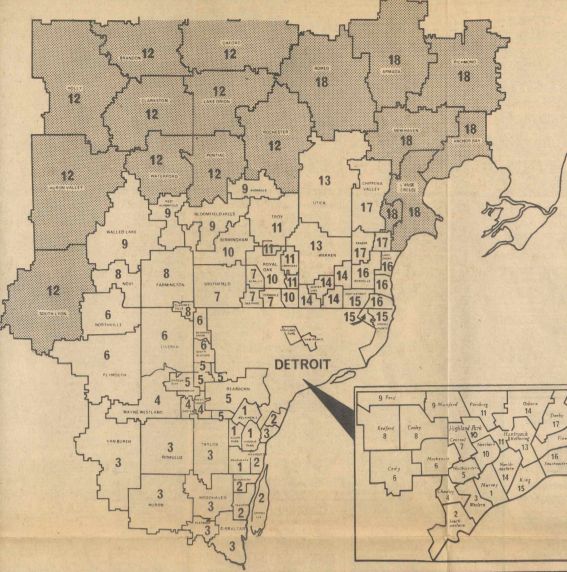Education NOW: The role of New Detroit Inc. and public engagement in reshaping Detroit's public schools
How might the relationship and flow of information between parents and the Detroit Board of Education affect the quality and locality of a child’s education? How were the parents of children involved in the inter-district busing debate of the early 1970s informed on the judicial and legal changes factoring into their children’s education?
 Available as part of the Walter P. Reuther Library and Archive of Urban Affairs collection on Detroit Public Schools Community Relations Division, the records of New Detroit Inc on Integration offer a relevance to the present day for their ability to showcase the connection between the funding of public schools in the state of Michigan and the effects of the flight of wealthier citizens on the city tax base needed to keep schools open and the quality of education high. By offering various contexts on the debates and mediation of information regarding desegregation and inter-district busing in Detroit during the 1970s, these materials provide the viewer a connection and the tools to work toward a deeper understanding of historic and current struggle for a quality and accessible public education and the effects of racial tensions on the promise of education in the city of Detroit.
Available as part of the Walter P. Reuther Library and Archive of Urban Affairs collection on Detroit Public Schools Community Relations Division, the records of New Detroit Inc on Integration offer a relevance to the present day for their ability to showcase the connection between the funding of public schools in the state of Michigan and the effects of the flight of wealthier citizens on the city tax base needed to keep schools open and the quality of education high. By offering various contexts on the debates and mediation of information regarding desegregation and inter-district busing in Detroit during the 1970s, these materials provide the viewer a connection and the tools to work toward a deeper understanding of historic and current struggle for a quality and accessible public education and the effects of racial tensions on the promise of education in the city of Detroit.
Dated December of 1970 and titled: “The 8 Regions of Decentralization …. Some Answers,” the pamphlet published and circulated by New Detroit, a civil rights and racial harmony organization founded following the civil unrest of 1967, primarily contains information on the process and debate of school board decentralization advocating for the benefits of the plan on the quality of Detroit public education. The pamphlet also provides information on the roles of the school board and community within the decentralization process, including a chronology and explanation of the legal cases pre-dating and relevant to the circuit court and later supreme court rulings of Milliken v. Bradley. Also present in the pamphlet is a map of the proposed decentralized 8-zone district of Detroit Public Schools for the democratization of the school board as laid out by Public Act 48 and a description of the 7-11 zones proposed by the preceding Public Act 244 and the differences between the two acts. The amount of legal and logistical information embedded in such a compact circular sheds light on the state confusion and disconnect between parents, the school board, and legislative authority in the midst of heavy debate and changes made as a result of the shifting proposals and precedents of the debate on inter-district busing in Detroit Public Schools.
The collection also offers particular access to the BDE’s views and plans for compliance with legislative desegregation and the district’s dissemination of information to the public through a print text and informational brochure of Public Act 48. This brochure provides details of the board’s plans for decentralization in October of 1970, explaining the logistical process of decentralization and the proposed effect of the process on parents and students of the affected districts in specific relation to Public Act 48. This component of the collection contributes to the understanding of the chaos and confusion of the inter-district bussing debate in Detroit by demonstrating the extensiveness and density of the legal documents and changes needed to be interpreted by parents. The materials from the BDE also provide insight to the need for a pamphlet like the “...Answers” pamphlet circulated by New Detroit two months later, which offers a similar legal and legislative interpretation in a more straightforward and discernible presentation and format.
 In addition to the materials of New Detroit Inc. and the BDE, the collection contains a Detroit News article from March of 1972 outlying the “cluster” proposal for 18 zones within the district, coupled with charts of the racial composition of the student bodies of the Detroit and suburban school districts comprising the corresponding zones. This clipping’s emphasis on racial composition and lack of focus on the legal aspects of the would-be “cluster” proposal demonstrates the greater significance of racial composition to parents within the Detroit school district, alluding to the subtextual motivations behind the exodus of wealthier families from the BDE’s constituency and the increased inaccessibility of a quality education available to students from lower-income family backgrounds.
In addition to the materials of New Detroit Inc. and the BDE, the collection contains a Detroit News article from March of 1972 outlying the “cluster” proposal for 18 zones within the district, coupled with charts of the racial composition of the student bodies of the Detroit and suburban school districts comprising the corresponding zones. This clipping’s emphasis on racial composition and lack of focus on the legal aspects of the would-be “cluster” proposal demonstrates the greater significance of racial composition to parents within the Detroit school district, alluding to the subtextual motivations behind the exodus of wealthier families from the BDE’s constituency and the increased inaccessibility of a quality education available to students from lower-income family backgrounds.
This post was authored by Arik Fritz, a student in Wayne State University's Department of History, in 2021.


 Reddit
Reddit Facebook
Facebook LinkedIn
LinkedIn